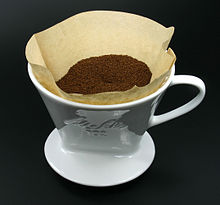Brewed coffee

Brewed coffee is made by pouring hot water onto ground coffee beans, then allowing to brew. There are several methods for doing this, including using a filter, a percolator, and a French press. Terms used for the resulting coffee often reflect the method used, such as drip brewed coffee, filtered coffee, pour-over coffee, immersion brewed coffee, or simply coffee. Water seeps through the ground coffee, absorbing its constituent chemical compounds, and then passes through a filter. The used coffee grounds are retained in the filter, while the brewed coffee is collected in a vessel such as a carafe or pot.
History[]
Paper coffee filters were invented in Germany by Melitta Bentz in 1908[1] and are commonly used for drip brew all over the world. In 1954 the Wigomat, invented by , was patented in Germany being the first electrical drip brewer.[2] Drip brew coffee makers replaced the coffee percolator in the 1970s due to the percolators' tendency to over-extract coffee, thereby making it bitter.[3] One benefit of paper filters is that the used grounds and the filter may be disposed of together, without a need to clean the filter. Permanent filters are now also common, made of thin perforated metal sheets, fine plastic mesh or porous ceramics that restrain the grounds but allow the coffee to pass, thus eliminating the need to have to purchase separate filters which sometimes cannot be found in some parts of the world. These add to the maintenance of the machine, but reduce overall cost and produce less waste.
Characteristics[]

Brewing with a paper filter produces clear, light-bodied coffee. While free of sediments, such coffee is lacking in some of coffee's oils and essences; they have been trapped in the paper filter.[4] Metal filters do not remove these components.[5]
It may be observed, especially when using a tall, narrow carafe, that the coffee at the bottom of the coffeepot is stronger than that at the top. This is because less flavor is available for extraction from the coffee grounds as the brewing process progresses. A mathematical argument has been made that delivering comparable strength in two cups of coffee is nearly achieved using a Thue-Morse sequence of pours.[6] This analysis prompted a whimsical article in the popular press.[7]
There are several manual drip-brewing devices on the market, offering a little more control over brewing parameters than automatic machines, and which incorporate stopper valves and other innovations that offer greater control over steeping time and the proportion of coffee to water. There also exist small, portable, single-serving drip brew makers that only hold the filter and rest on top of a mug or cup, making them a popular option for backcountry campers and hikers. Hot water is poured in and drips directly into the cup.
A less familiar form of drip brewing is the reversible or "flip" pot commonly known as Napoletana.
Cultural impact[]

The Drip-O-lator is a patented coffee pot for making drip coffee patented in 1921 and in 1930 and manufactured in Massillon, Ohio,[8] or Macon, Georgia,[9] United States. The production of Drip-O-lators ceased in the middle of the twentieth century. The pots have become collectibles similar to bric-à-brac.[10]

Filter coffee is central to Japanese coffee culture and connoisseurship.[11]
In South India, filter coffee brewed at home is known as Kaapi, and is a part of local culture. Most houses have a stainless steel coffee filter and most shops sell freshly roasted and ground coffee beans. Some popular filter coffee brands include Mysore café, Hill coffee (Suresh healthcare), Cothas Coffee (Bangalore) and Narasu's Coffee (Salem). It is common in South India and Louisiana to add an additive called chicory to coffee to give it a unique taste and flavour.[12]
See also[]
- Chemex
- Chorreador
- Coffeemaker
- Coffee bag
- Coffee percolator
- French press
- Indian filter coffee
- Instant coffee
- List of coffee drinks
- Trojan Room coffee pot
- Turkish coffee
References[]
- ^ "The History of How We Make Coffee". About.com. Retrieved 13 February 2012.
- ^ "Sixty years of the Federal Republic of Germany – a retrospective of everyday life". Retrieved 28 December 2012.
- ^ "Perfectcoffeemakers.com". www.perfectcoffeemakers.com. Archived from the original on 2014-03-18. Retrieved 2012-09-18.
- ^ "How to Use a Pour Over Brewer" Archived 2011-10-23 at the Wayback Machine CoffeeGeek.com. October 21, 2005.
- ^ Cornelis MC, El-Sohemy A (November 2007). "Coffee, caffeine, and coronary heart disease". Curr Opin Clin Nutr Metab Care. 10 (6): 745–51. doi:10.1097/MCO.0b013e3282f05d81. PMID 18089957.
- ^ Richman, Robert (2001). "Recursive Binary Sequences of Differences" (PDF). Complex Systems. 13 (4): 381–392. Retrieved 19 February 2013.
- ^ Abrahams, Marc (12 July 2010). "How to pour the perfect cup of coffee". The Guardian. Retrieved 19 February 2013.
- ^ Patent number 1370782[permanent dead link]
- ^ Patent #1743925[permanent dead link]
- ^ Drip-O-lator
- ^ Strand, Oliver (9 February 2011). "Coffee's Slow Dance". The New York Times. Retrieved 7 December 2019.
- ^ Thomas, Rans (2012-01-11). "Chicory: A Powerful Perennial". Quality Deer Management Association. Archived from the original on 11 January 2012. Retrieved 29 September 2018.
External links[]
- Coffee preparation
- Coffee culture
